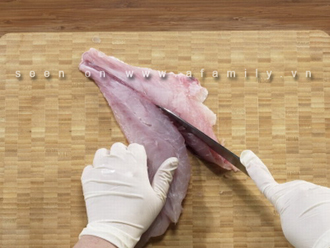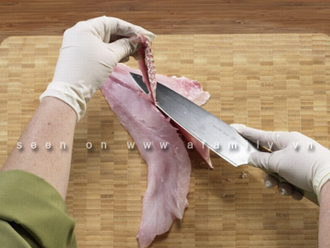 |
When filleting fish, it is important to select fresh fish with firm flesh, clear fish eyes, and no fishy smell. Scale the fish and rinse it under running water. |
 |
To fillet the fish, hold it firmly and make a diagonal cut from the belly to the backbone. Repeat on the other side, keeping the knife close to the spine. |
 |
Turn the fish over and use the tip of the knife to cut a shallow line along the spine from head to tail. |
 |
Press your hand firmly on the fish to stabilize it and carefully slice along the fish from head to tail, close to the spine. |
 |
After flipping the fish fillet, use the tip of the knife to gently remove any remaining bones from the fish belly. |
 |
Repeat the above steps on the other side of the fish, starting from the tail and slicing towards the head. |
 |
Cut out the fillets and check for any remaining bones in the fish belly. Remove them before using the fillets for cooking. |
 |
Once the fillets are ready, you can use them to prepare various delicious dishes such as stir-fried fish or breaded fish. Removing the bones makes it safer to serve fish to children. |
 |
When removing the fish fat, which may have a strong odor, make two cuts in the shape of a “V” on each side of the fillet and lift it out. |
 |
The remaining fish bones can be used to make a flavorful vegetable soup.
|
 |
There may be a brownish-red line of fish fat along the fillet, which can be removed if desired. |
 |
Make two cuts in the shape of a “V” on both sides of the fillet to remove the fish fat. |
 |
Lift the fish fat out of the fillet. |
 |
Finally, check for any remaining bones in the fish belly and remove them before using the fillets. |







































